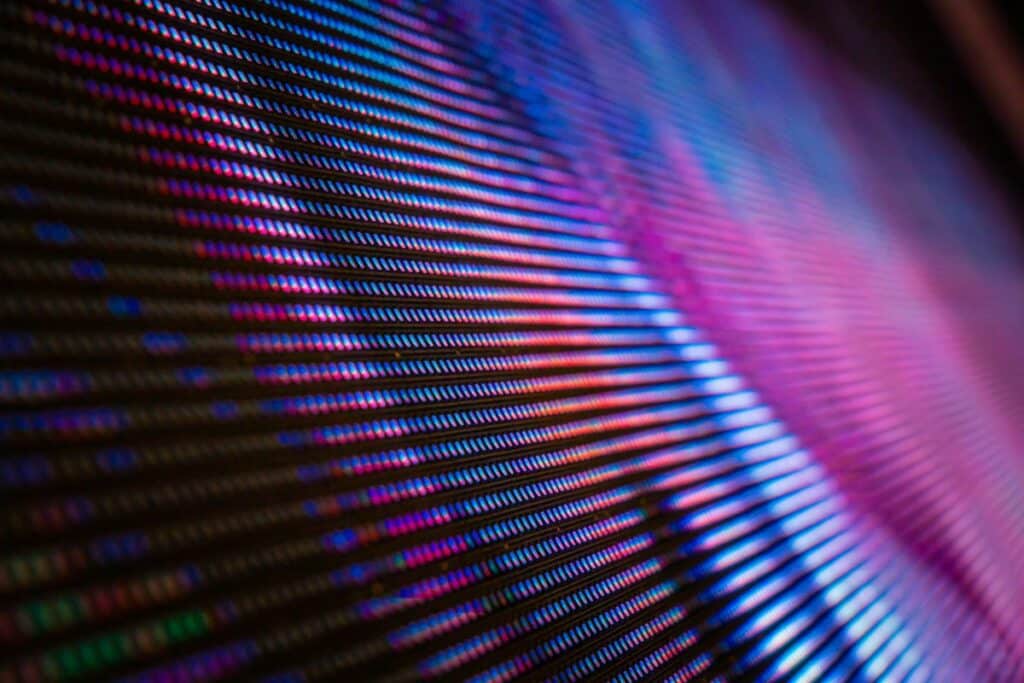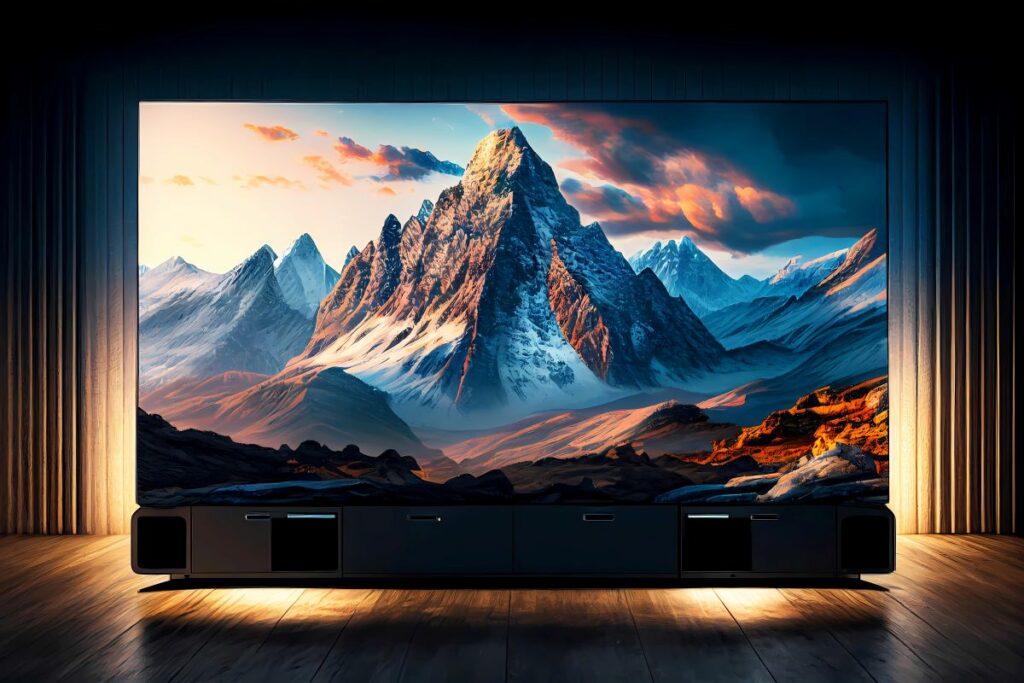the essentials in brief
LCD and LED use liquid crystals and backlight for image generation, while OLEDs use self-luminous organic diodes. Details here...
Both technologies have their advantages and disadvantages. While LED TVs usually offer better contrast and color representation, LCD TVs are often less expensive. More on the topic here...
LEDs are generally more energy efficient than LCDs and can bring savings in this regard.
In the increasingly complex world of display technologies, many consumers are faced with the difficult decision between LCD and LED. The two terms are often used interchangeably, although there are significant differences between them. In this article you will find out everything important about LCD and LED, your Advantages and disadvantages and the factors you should consider when choosing a TV or monitor.
Contents
Deeper insights: Differences between LCD, LED and OLED

In order to fully understand the differences between LCD, LED and OLED, it is important to understand the technical fundamentals of these technologies.
LCD technology
The LCD technology based on liquid crystals, which modulate the light that passes through them. You can the polarization of the light and thereby vary the amount of light that passes through the screen. This technique enables the display of images. An important feature of LCD screens is that they need backlight. With older LCD televisions, this was done with so-called cold cathode fluorescent lamps (CCFLs) reached.
LED technology
LED TVs are actually one Subspecies of LCD TVs. They also use liquid crystals to create the image. The difference lies in the type of backlight. Instead of CCFLs become at LED TVs Light Emitting Diodes (LEDs) used. These can either be attached to the edges of the screen (edge lighting) or across the entire back of the screen (full surface lighting).
Additional information: LED TVs have a longer lifespan than LCD TVs. According to a study by the US Consumer Electronics Association (CEA), LED TVs have an average lifespan of 100.000 hours, while LCD TVs last around 60.000 hours on average.
OLED technology
OLED TVs take a different approach. Here they exist pixel from organic compounds, which emit light when current is passed through them. Therefore, OLEDs do not require a backlight, which they do thinner and more energy efficient might. In addition, this technology enables a perfect black, since individual pixels can be completely switched off.
Other Technologies
Apart from LCD, LED and OLED, there are still other display technologies, including Plasma, Quantum Dot and MicroLED.
- plasma screens have gas-filled cells that glow when excited by electrical impulses. They can display extremely high contrast and vivid color, but tend to be larger, heavier, and use more power than other types of screens.
- Quantum Dot Screens are a further development of LED technology and use tiny particles that glow when illuminated. They produce more vivid colors and a brighter image than traditional LED screens.
- MicroLED displays use millions of tiny self-illuminating diodes and are similar in function to OLEDs. However, they offer longer life and are less prone to burn-in.
LED vs. LCD: The ultimate screen type comparison

When choosing a television or monitor, many consumers are faced with the question of whether to go for one LED or LCD screen should decide. Both technologies have their own advantages and disadvantagesthat need to be taken into account. To make an informed decision, let's look at the Strengths and weaknesses of LED and LCD screens Take a closer look and consider which type of screen is more suitable for certain requirements.
LCD screens: the classic
Use LCD screens liquid crystals and a backlightto display images. Here are the pros and cons of LCD screens:
LED screens: the energy-efficient alternative
LED screens are one Further development of LCD technology and use light-emitting diodes (LEDs) for backlighting. Here are the pros and cons of LED screens:
Which screen type is suitable for whom?
The choice between LED and LCD screens depends on the individual needs and preferences away. Here are some scenarios where a particular screen type may be more appropriate:
- LCD screens: If you are on a budget and looking for value for money, LCD screens can be a good choice. They are well suited for general home use when the highest image quality is not a priority.
- LED screens: If you value improved picture quality, higher contrast and energy efficiency, LED screens are a better choice. They are ideal for movie and gaming enthusiasts as well as those who prefer a sleek and modern design.
Overall there is no general "better" or "worse" between LED and LCD screens. Both have their advantages and disadvantages. It matters, yours individual requirements, consider the intended use and your budget to make the right choice.
Energy efficiency: LCD vs. LED and other economical screen types

The energy consumption of screens plays a role important role in the choice a television or monitor. The technology that is used affects the energy consumption significantly. Let's take a closer look at which ones Technology between LCD and LED uses less energy and take a look at other energy-efficient screen types and tips on how to save even more energy.
LCD vs. LED: Who is the energy saving master?
In general are LED screens more energy efficient than traditional LCD screens with cold cathode fluorescent lamps (CCFLs). Here are the reasons:
- Backlight: In LCD panels with CCFLs, the backlight is generated by gas discharge, resulting in higher power consumption. LED screens, on the other hand, use light-emitting diodes that require less energy.
- Backlight control: LEDs allow for more precise backlight control. This makes it possible to optimize energy consumption by adjusting the brightness depending on the needs of the content. As a result, darker scenes are presented with less backlight, which saves energy.
- efficiency of the LEDs: LEDs are more energy efficient than CCFLs. They convert a larger proportion of the supplied energy into light and generate less heat.
However, it is important to note that the Energy consumption also depends on other factors, such as screen size, brightness setting and usage time. Larger screens and higher brightness settings typically use more power.
Additional information: LED TVs are more environmentally friendly than LCD TVs. Due to their lower energy consumption, they help to reduce CO2 emissions. According to a study by the EU Commission, replacing LCD televisions with energy-efficient LED televisions can lead to annual CO2 savings of up to 1,4 million tons.
More economical screen types
In addition to LED screens, there are also other technologies that offer energy efficiency:
- OLED screens: OLED displays are more energy efficient than LCDs because they are self-illuminating and do not require a backlight. Each pixel emits its own light, making dark scenes with pixels off produce a true black. This contributes to energy saving.
- E Ink Displays: E-ink displays used in e-book readers are extremely energy efficient. They only consume energy when changing content and keep the displayed text or graphic without additional energy consumption.
Tips for saving energy
Here are some practical tipshow you can further reduce the energy consumption of your screen:
- adjust brightness: Reduce the brightness of the screen to a comfortable level. High brightness settings use more energy.
- Automatic shutdown: Activate the function for auto off or standby mode when the screen is not used for a long time.
- Use energy saving mode: Many screens offer a special energy saving mode. Activate this function to further reduce energy consumption.
- Limit screen time: Limit the screen usage time to reduce power consumption.
- Use power saver: Use a power-saving plug or a switched power strip to completely cut power to the screen when not in use.
By following these tips and a energy-efficient screen type you can significantly reduce your energy consumption and help protect the environment.
LED vs. LCD: Finding the screen that makes you shine
In conclusion, it can be said that both LCD and LED technology have their advantages. While LEDs shine in terms of image quality and energy efficiency, LCDs offer a cost-effective alternative. Your decision should be yours individual requirements and your budget judge. Armed with these insights, you'll be best equipped to find the screen that makes you shine.

![Samsung Neo QLED 8K TV QN700A 65 inch (GQ65QN700ATXZG), Quantum HDR 2000, Quantum Matrix technology, Slim One Connect [2021]](https://m.media-amazon.com/images/I/51ISEPCvPfS.jpg)